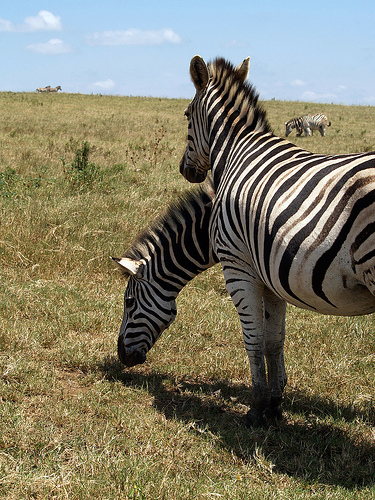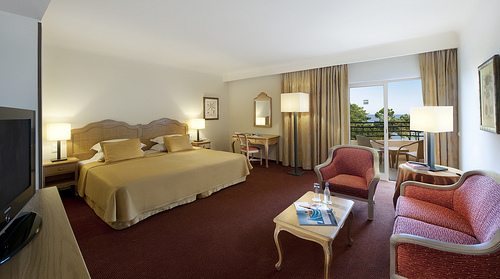Model Card for Logic2Vision
Logic2Vision is a LLaVA-1.5-13B model finetuned on VisReas dataset for complex visual reasoning tasks.
Model Details
Model Description
Logic2Vision is a LLaVA-1.5-13B model finetuned on VisReas dataset for complex visual reasoning tasks. The model has been finetuned using LoRA to generate python pseudocode outputs to solve a complex visual reasoning tasks.
- Developed by: Sangwu Lee and Syeda Akter
- Model type: Multimodal (Text + Image)
- Language(s) (NLP): English
- License: MIT
- Finetuned from model: LLaVA-1.5-13B
Model Sources
- Repository: TBD
- Paper: VisReas dataset
Uses
The inference method is similar to LLaVA-1.5-13B.
Example images
- Q: What else in the image is striped as the rope and the mane to the left of the white clouds?
- A: Question is problematic. There are a couple zebras (i.e. mane/horses) at the back left of the clouds. But, there are clearly no ropes in the image.
Question
- Q: What material do the chair and the table have in common?
- A: Wood.
Code
import torch
from transformers import LlavaProcessor, LlavaForConditionalGeneration
import requests
from PIL import Image
class LLaVACodeTemplate:
prompt = """
USER: <image>
Executes the code and logs the results step-by-step to provide an answer to the question.
Question
{question}
Code
{codes}
ASSISTANT:
Log
"""
answer = """
{logs}
Answer:
{answer}</s>
"""
template = LLaVACodeTemplate()
model = LlavaForConditionalGeneration.from_pretrained("RE-N-Y/logic2vision", torch_dtype=torch.bfloat16, low_cpu_mem_usage=True, cache_dir="/data/tir/projects/tir6/general/sakter/cache")
model.to("cuda")
processor = LlavaProcessor.from_pretrained("RE-N-Y/logic2vision")
processor.tokenizer.pad_token = processor.tokenizer.eos_token
processor.tokenizer.padding_side = "left"
image = Image.open(requests.get("https://huggingface.co/RE-N-Y/logic2vision/resolve/main/zebras.jpg", stream=True).raw)
question = "What else in the image is striped as the rope and the mane to the left of the white clouds?"
codes = """selected_clouds = select(clouds)
filtered_clouds = filter(selected_clouds, ['white'])
related_mane = relate(mane, to the left of, o, filtered_clouds)
selected_rope = select(rope)
pattern = query_pattern(['selected_rope', 'related_mane'])
result = select(objects, attr=pattern)
"""
prompt = template.prompt.format(question=question, codes=codes)
inputs = processor(images=image, text=prompt, return_tensors="pt")
inputs.to("cuda")
generate_ids = model.generate(**inputs, max_new_tokens=256)
output = processor.batch_decode(generate_ids, skip_special_tokens=True)
print(output[0])
# USER:
# Executes the code and logs the results step-by-step to provide an answer to the question.
# Question
# What else in the image is striped as the rope and the mane to the left of the white clouds?
# Code
# selected_clouds = select(clouds)
# filtered_clouds = filter(selected_clouds, ['white'])
# related_mane = relate(mane, to the left of, o, filtered_clouds)
# selected_rope = select(rope)
# pattern = query_pattern(['selected_rope', 'related_mane'])
# result = select(objects, attr=pattern)
# ASSISTANT:
# Log
# ('clouds', ['white'])
# ('clouds', ['white'])
# ('mane', ['striped'])
# ('rope', ['no object'])
# ['the question itself is problematic']
# ['the question itself is problematic']
# Answer:
# the question itself is problematic
image = Image.open(requests.get("https://huggingface.co/RE-N-Y/logic2vision/resolve/main/room.jpg", stream=True).raw)
question = "What material do the chair and the table have in common?"
codes = """selected_chair = select(chair)
selected_table = select(table)
materials = query_material([selected_chair, selected_table])
common_material = common(materials)
"""
prompt = template.prompt.format(question=question, codes=codes)
inputs = processor(images=image, text=prompt, return_tensors="pt")
inputs.to("cuda")
generate_ids = model.generate(**inputs, max_new_tokens=256)
output = processor.batch_decode(generate_ids, skip_special_tokens=True)
print(output[0])
# USER:
# Executes the code and logs the results step-by-step to provide an answer to the question.
# Question
# What material do the chair and the table have in common?
# Code
# selected_chair = select(chair)
# selected_table = select(table)
# materials = query_material([selected_chair, selected_table])
# common_material = common(materials)
# ASSISTANT:
# Log
# ('chair', ['wood'])
# ('table', ['wood'])
# [['wood'], ['wood']]
# ['wood']
# Answer:
# wood
Bias, Risks, and Limitations
The model has been mostly trained on VisReas dataset which is generated from Visual Genome dataset. Furthermore, since the VLM was mostly finetuned to solve visual reasoning tasks by "generating python pseudocode" outputs provided by the user. Hence, it may struggle to adopt to different prompt styles and code formats.
Training / Evaluation Details
The model has been finetuned using 2 A6000 GPUs on CMU LTI's Babel cluster. The model has been finetuned using LoRA (r=8, alpha=16, dropout=0.05, task_type="CAUSAL_LM").
LoRA modules were attached to ["q_proj", "v_proj"]. We use DDP for distributed training and BF16 to speed up training. For more details, check our paper!
Results
Citation
BibTeX:
@misc{akter2024visreas,
title={VISREAS: Complex Visual Reasoning with Unanswerable Questions},
author={Syeda Nahida Akter and Sangwu Lee and Yingshan Chang and Yonatan Bisk and Eric Nyberg},
year={2024},
eprint={2403.10534},
archivePrefix={arXiv},
primaryClass={cs.CV}
}
Model Card Authors
- Sangwu Lee - Google Scholar - Github - LinkedIn
- Syeda Akter - Google Scholar - Github - LinkedIn
- Downloads last month
- 6



